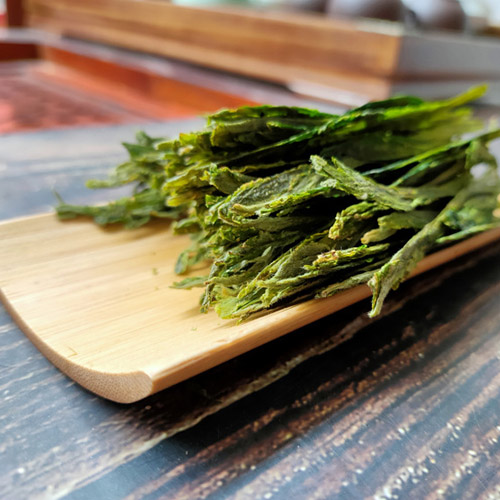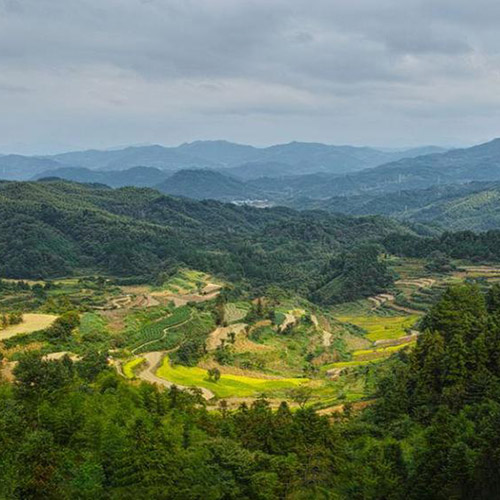<Hui Tea> Taiping Houkui
[Taiping Houkui] One of the top ten famous teas in the country. It is produced in Xinming Township, Huangshan District. The sharp tea from the Houkeng Mountain Tea Garden is of the best quality, and it is called "Hukui". When it is brewed in the cup, the buds and leaves become flowers, hanging or sinking, hanging in the clear and green tea meter. It seems that there are many little monkeys stretching their heads and tails to you in the cup. The taste is bright green, mellow and sweet, the aroma is high and refreshing and lasting, and the soup color is clear and green.

Solar terms are the horn of plant growth. Before Gu Yu, when the first seedlings were planted in the green fields at the foot of Huangshan Mountain, on the top of the hill behind Sanhe Village, tea trees named Persimmons were quietly gestating new buds in the sun. The sturdy leaves from the spire of the tea tree will become a legendary tea-Taiping Houkui in more than ten days.
In Taiping Houkui, the core, high-quality, and most expensive producing area are the three villagers groups of Houkeng, Hogang, and Yanjia. Among them, Hou Keng has always been said by the outside world that Hou Keng is just an ordinary mountain village, and it is famous because of Hou Kui.
In 1970, the Chencun Reservoir, located between Jing County and Taiping County, began to store water, forming a water surface of more than 50 square kilometers of Taiping Lake. Since the water storage area is located in the mountainous area, the edge of Taiping Lake is curved around. Star Luo. From a high altitude, the shape of Taiping Lake is amazing, like a giant dragon flying into the sky.
Hou Keng (Monkey Cave) is a group of villagers belonging to Sanhe Village. The elevation here is about 500 meters above sea level. The twenty-odd households in Houkeng are the most envied in the entire Taiping Lake area. Their tea garden is located in the core area of Taiping Houkui. They produce the highest price of tea, and their tea never comes out of the mountain, and customers go to the mountain to buy with the mentality of exploring the secrets. Although Hou Keng is the territory of Sanhe Village, it is the drop of several hundred meters that caused a gap in the quality of Hukui between the Hou Keng on the mountain and the Sanhe at the bottom of the mountain. More importantly, the price of tea produced in Hou Keng is three times higher than that of the mountain. In the spring of 2011, the top Taiping Houkui fried by Houkeng tea farmers sold for 4,000 yuan a catty.
The high quality of the tea in Hou Keng is inseparable from its geographical location. In Hou Keng, it is common for a sea of clouds to pass over people's heads. Cloud mist is the best milk for tea. The monkey pit is surrounded by mountains, and it is easy to gather water vapor. Tea trees grow vigorously among the clouds and smoke of suitable shades. In 2012, the price of tea has been rising all the way. The first batch of Taiping Houkui before Gu Yu is even more precious. To fry such tea, you have to fight time and speed, and the various processes must be closely coordinated.
Early in the morning, the tea workers will go up the mountain to pick tea in the sun. The head monkey head before Gu Yu was fried with two big leaves and one bud. The buds and leaves should be roughly level, and the size should be basically the same. In one morning, each tea worker can only harvest less than two catties of fresh leaves. The harvested tea leaves need to be spread on the basket. One to two hours after the dew has dried up, the first step is to be done-sautéing the tea.
Charcoal is used for the fire, and the pot is a wok. The amount of fresh leaves in the iron pan is controlled at about two to three. When one pan is fried, it takes less than five minutes. This time is longer than that of fried bud tea, because the leaves of Houkui are larger and more watery. It needs to be shaken more than forty times to heat the tea evenly and promote the formation of aroma.
The fried tea leaves must quickly enter the next process-sorting. This is a process that is not found in other tea leaves. Every tea made from Taiping Houkui is sorted out one by one patiently. At this time, the leaves are slightly darker in color, tougher, a little tea juice is secreted, and their hands are slightly sticky. The tea workers are quick to sort out the strips. They pinch the two ends of the leaves and twist with two fingers to make the two leaves tight. Hugging a bud tightly. A skilled tea worker can sort out one piece in about 5 seconds, and there are about 2,800 pieces of Taiping Houkui per jin of finished product.
In the third and fourth steps, the twisted tea strips are placed on a silk screen, covered with a piece of earthen cloth, and then the loose tea leaves are pressed tightly with a pressing roller. After pressing, tap with bamboo strips to separate the tea strips stuck on the cloth. This step is called shaping.
As with all green teas, roasting is the last step. The tool for baking tea is a square oven with four layers, similar to a steamed bun. Below the oven is a charcoal fire. The prepared tea leaves are roasted four times. The temperature of the first layer below is the highest, reaching above 100 degrees, and then the temperature gradually decreases to 90 degrees, 80 degrees, and 70 degrees. This work requires the use of both hands and feet. First put the tea leaves on the first layer, about 30 seconds later, lift to the second layer, and so on, until the fourth layer. Houkui’s new tea is finished.
This is a time and fire project. In the process of hand-made tea from generation to generation, some crafts have disappeared, some crafts have been modified, and some new crafts have been added.
Before Taiping Houkui became famous, its name was Taiping Kuijian. The roasting history of this kind of big-leaf pointed tea has been popular since the late Ming Dynasty. After tea farmers gradually explored and improved, the modern Houkui stir-frying technology has gradually formed. The tea farmers in the monkey pit are used to working hard on the big leaf tea. They have to wait until after the rain in the spring each year before they start picking the two fattest leaves and one bud on the tea tree. The locals call it two knives and one shot. In order to make the tea look good, the size of the picked leaf buds must be unified up to 5 cm.
Drinking freshly roasted tea is not the best choice, but for impatient people, rushing to have a bite is also out of anticipation of the famous tea Houkui. The finished Houkui leaves are straight and slender, flat and even, plump and strong, with a pale green color. The spring water from the mountain stream is poured into the cup, and you can see the buds and leaves slowly unfolding the bones, two leaves holding a bud, or hanging or sinking , Clustered in the cup. From the tip of the nose, the green tea soup exudes a long orchid fragrance. There is a unique monkey rhyme in the tea fragrance, light taste, mellow and sweet.
In the tranquil Sanhe Village in the depths of Taiping Lake, three gates were set up during the tea season to prevent fresh leaves from entering the village and prevent them from becoming monkeys of their origin.
Monopoly is sometimes not a bad thing. Under the agitation of various forces, the legend of Taiping Houkui and Hou Keng, looking around, extends towards the years to come.
Hou Keng (Monkey Cave)

Latest Articles - Teawiki
Why Is Kenyan Black Tea So Popular Around The World?
Kenya is the world's largest exporter of tea. 450,000 tea farmers work hard throughout the four seasons on 186,000 hectares of tea gardens, contributing 1/10 of the world's tea - 400,000 tons of black tea every year. Nearly half of the black tea consumed in the UK comes from Kenya.
Golden Royal Chrysanthemum
Golden Royal Chrysanthemum, a kind of scented tea, is referred to as Royal Chrysanthemum, also known as Nine Immortals Royal Chrysanthemum. It originated from Xiabao Village, known as Little Shangri-La, located in Fengxin County, northwest Jiangxi. Fengxin County has a subtropical humid monsoon climate zone. Light, heat and water resources are relatively abundant, the frost period is relatively short, and agricultural production conditions are relatively superior, which is very suitable for the growth of chrysanthemums
Is Gynostemma Pentaphyllum Tea Better With Seven Leaves Or Five Leaves
Each drink has its own benefits depending on the purpose of the drink.
Jiangxi Famous Tea - Zixi White Tea
Zixi white tea is a lightly fermented tea that belongs to the white tea category among the six major tea categories. Zixi white tea is made from the buds and leaves of extra-large pekoe, which are processed using a unique and precise method without kneading and frying. It has the characteristics of fresh taste, goose-yellow soup color, clear and bright, and sweet aftertaste.
